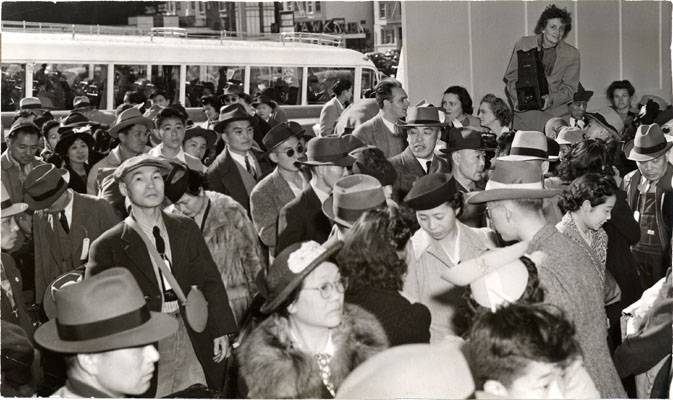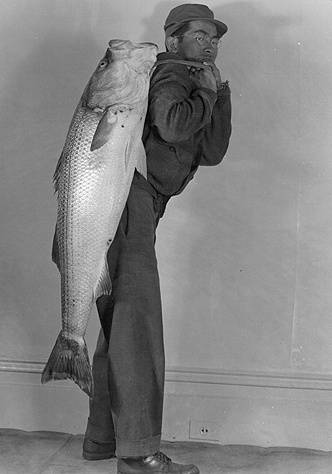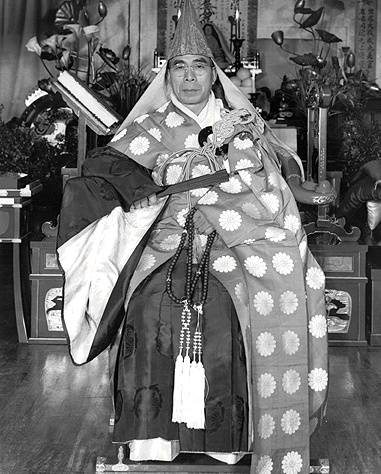Japanese Internment: Difference between revisions
No edit summary |
added photos |
||
| Line 31: | Line 31: | ||
In early 1942, President Franklin Roosevelt signed Executive Order 9066, ordering Japanese Americans on the West Coast to be incarcerated in internment camps. The Japanese community in San Francisco was treated like an enemy alien population. Any person of Japanese ancestry was required to sell their belongings, give up their homes and move into temporary relocation camps (usually race tracks) while internment facilities were built in the interior of the country. (The Buddhist Temple on Octavia near Bush is where many Japanese stored their belongings during the internment. Some of the first people sent to the camps were Shinto, Buddhist and Presbyterian priests because they were community leaders.) | In early 1942, President Franklin Roosevelt signed Executive Order 9066, ordering Japanese Americans on the West Coast to be incarcerated in internment camps. The Japanese community in San Francisco was treated like an enemy alien population. Any person of Japanese ancestry was required to sell their belongings, give up their homes and move into temporary relocation camps (usually race tracks) while internment facilities were built in the interior of the country. (The Buddhist Temple on Octavia near Bush is where many Japanese stored their belongings during the internment. Some of the first people sent to the camps were Shinto, Buddhist and Presbyterian priests because they were community leaders.) | ||
[[Image:Tanforan Relocation Camp aerial view via Alan Ochoa FB.jpg|800px]] | |||
'''Tanforan Relocation Camp in San Mateo, the former horse racing track converted into a concentration camp for Japanese internees in 1942.''' | |||
''Photo: via Alan Ochoa's Facebook page'' | |||
[[Image:Tanforan Assembly Center unofficial newsletter map via Alan Ochoa FB.jpg|800px]] | |||
'''Tanforan "Assembly Center" unofficial newsletter map. (click to enlarge)''' | |||
''Photo: via Alan Ochoa's Facebook page'' | |||
<iframe src="https://archive.org/embed/ssfjapint" width="640" height="480" frameborder="0" webkitallowfullscreen="true" mozallowfullscreen="true" allowfullscreen></iframe> | <iframe src="https://archive.org/embed/ssfjapint" width="640" height="480" frameborder="0" webkitallowfullscreen="true" mozallowfullscreen="true" allowfullscreen></iframe> | ||
<font size=4>Rounded up for Internment</font size> | |||
Japanese Americans were considered spies and a threat to the war effort against Japan. Ironically, many Japanese Americans served as spies on the American side of the war and others left the camps to lose their lives on the battle field under the American flag. | Japanese Americans were considered spies and a threat to the war effort against Japan. Ironically, many Japanese Americans served as spies on the American side of the war and others left the camps to lose their lives on the battle field under the American flag. | ||
Latest revision as of 14:03, 9 July 2020
Historical Essay
by Northern California Coalition on Immigrant Rights
Japanese internment begins with forced evacuation from San Francisco on April 7, 1942. Dorothea Lange, well-known documentary photographer of the Depression, is on wall in background with large format camera.
Photo: San Francisco History Center, SF Public Library
Japanese-Americans waiting on Van Ness to be transported to internment camps, 1942.
Photo: Dorothea Lange, WPA
East Bay Yesterday podcast on the fraudulent justifications for Japanese internment.
Courtesy East Bay Yesterday
Japanese being taken away for internment, April 6, 1942.
Photo: Bancroft Library
In the late 1800s, most Japanese lived on Rincon Hill, near South Park in the South of Market area. After the 1906 earthquake, the Japanese community moved out to the Western Addition near the intersection of Post and Laguna streets. There they established Nihonmachi or Japanese town, now known as Japantown.
In early 1942, President Franklin Roosevelt signed Executive Order 9066, ordering Japanese Americans on the West Coast to be incarcerated in internment camps. The Japanese community in San Francisco was treated like an enemy alien population. Any person of Japanese ancestry was required to sell their belongings, give up their homes and move into temporary relocation camps (usually race tracks) while internment facilities were built in the interior of the country. (The Buddhist Temple on Octavia near Bush is where many Japanese stored their belongings during the internment. Some of the first people sent to the camps were Shinto, Buddhist and Presbyterian priests because they were community leaders.)
Tanforan Relocation Camp in San Mateo, the former horse racing track converted into a concentration camp for Japanese internees in 1942.
Photo: via Alan Ochoa's Facebook page
Tanforan "Assembly Center" unofficial newsletter map. (click to enlarge)
Photo: via Alan Ochoa's Facebook page
Rounded up for Internment
Japanese Americans were considered spies and a threat to the war effort against Japan. Ironically, many Japanese Americans served as spies on the American side of the war and others left the camps to lose their lives on the battle field under the American flag.
Notably, Japanese Americans living in Hawaii were not interned, despite their greater numbers and the national security threat to that area following the Pearl Harbor bombing. Some theories assert that Japanese Americans were ordered removed from the coast of California not because they posed any national security threat, but because efficient Japanese farmers had taken over the agricultural industry from white farmers in states like California and Washington. The government feared an increase in Japanese American economic power since the agricultural industry would gain strength in a war time economy.
Whatever the reason for the U.S. removal of Japanese Americans from their homes, the imprisonment of so many U.S. citizens and residents was devastating to the Japanese community. Families lost their homes, businesses, and worldly belongings. They were incarcerated by a government that they considered their own and were thrown into horse stables unfit for human habitation.
The Japanese community proved resilient, however. Despite the atrocities committed against them during World War II, Japanese Americans returned to their homes after their incarceration in the camps and began the process of restoration. In San Francisco, although many Japanese Americans returned to their homes in Nihonmachi, some chose to move to the Richmond District.
Portrait with carp, c. 1950s
A decade or so later, those in Nihonmachi were forced to move again. At this time, Geary Boulevard was widened to provide middle-class residents of the Sunset and Richmond districts a major thoroughfare into downtown. This widening also effectively divided Japantown from Western Addition and the Fillmore, separating Japanese American and African American communities from each other. Also at this time, the land for Japan Center was sold to Kintetsu Corporation to build as a neighborhood shopping center. The corporation razed the existing Japantown/Koreatown along Post Street and built a more corporate and tourist-oriented complex, displacing many small business owners and residents who could no longer afford to live or do business there.
The northern boundary of Western Addition and Japantown has always been defined by the segregation practiced by the San Francisco real estate industry, which effectively barred minorities from moving in north of California Street. Although this practice legally ended in the 1960s with the enactment of fair housing laws, even today few people of color live north of this historic racial divide.
--courtesy Northern California Coalition for Immigrant Rights, from an immigrant history walking tour conducted Sept. 20, 1997
Ceremonial garb, c 1950s.
Unattributed photos on this page were discovered in a dumpster in Japantown in 1995.







